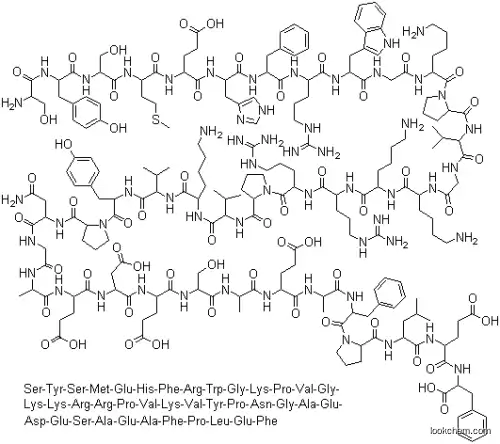
|
Basic Information |

|
Post buying leads |

|
Suppliers |
- Name Corticotropin
- EINECS232-659-7
- CAS No. 9002-60-2
- DensityN/A
- PSA1861.55000
- LogP5.65470
- SolubilityWater: 1 mg/mL
- Melting PointN/A
- FormulaC207H308N56O58S
- Boiling PointN/A
- Molecular Weight4541.07
- Flash PointN/A
- Transport InformationN/A
- AppearanceWhite or light yellow powder
- Safety22-36
- Risk Codes20/21/22-40
- Molecular Structure
- Hazard Symbols
 Xn
Xn - Synonyms
 Xn
Xn
Corticotropin Specification
The Adrenocorticotrophic hormone with CAS registry number of 9002-60-2 is also known as Corticotropin. The systematic name is Adrenocorticotropin. Its EINECS registry number is 232-659-7. In addition, the formula is C207H308N56O58S and the molecular weight is 4541.07. This chemical is a white or light yellow powder and should be sealed in brown glass bottle in cool, dry place.
Physical properties about Adrenocorticotrophic hormone are: (1)XLogP3-AA: -19.7; (2)H-Bond Donor: 63; (3)H-Bond Acceptor: 66; (4)Rotatable Bond Count: 148; (5)Tautomer Count: 1000; (6)Exact Mass: 4539.262728; (7)MonoIsotopic Mass: 4538.259373; (8)Topological Polar Surface Area: 1860; (9)Heavy Atom Count: 322; (10)Complexity: 11200; (11)Defined Atom StereoCenter Count: 36; (12)Covalently-Bonded Unit Count: 1.
Preparation of Adrenocorticotrophic hormone. Firstly, fresh pituitary is rapidly added into acetone to generate pituitary powder. Secondly, add acetone and hydrochloric acid to the power under stirring at 50 °C for 30 minutes. Then the reaction mixture is cooled to 30 °C and filtered twice. Sodium chloride solution and acetone are added to the mixture at 4 °C. At last, product is obtained by stirring, washing ang drying.
Uses of Adrenocorticotrophic hormone: it is used as hormone drug to promote the secretion of adrenocorticotropic hormone. It is also used for treatment of rheumatism, rheumatoid arthritis, systemic lupus erythematosus and other collagen disorders.
When you are using this chemical, please be cautious about it. As a chemical, it is harmful by inhalation, in contact with skin and if swallowed. However, there is limited evidence of a carcinogenic effect. During using it, wear suitable protective clothing and do not breathe dust.
You can still convert the following datas into molecular structure:
1. Canonical SMILES: CC(C)CC(C(=O)NC(CCC(=O)O)C(=O)NC(CC1=CC=CC=C1)C(=O)O)NC(=O)C2CCCN2C(=O)C(CC3=CC=CC=C3)NC(=O)C(C)NC(=O)C(CCC(=O)O)NC(=O)C(C)NC(=O)C(CO)NC(=O)C(CCC(=O)O)NC(=O)C(CC(=O)O)NC(=O)C(CCC(=O)O)NC(=O)C(C)NC(=O)CNC(=O)C(CC(=O)N)NC(=O)C4CCCN4C(=O)C(CC5=CC=C(C=C5)O)NC(=O)C(C(C)C)NC(=O)C(CCCCN)NC(=O)C(C(C)C)NC(=O)C6CCCN6C(=O)C(CCCNC(=N)N)NC(=O)C(CCCNC(=N)N)NC(=O)C(CCCCN)NC(=O)C(CCCCN)NC(=O)CNC(=O)C(C(C)C)NC(=O)C7CCCN7C(=O)C(CCCCN)NC(=O)CNC(=O)C(CC8=CNC9=CC=CC=C98)NC(=O)C(CCCNC(=N)N)NC(=O)C(CC1=CC=CC=C1)NC(=O)C(CC1=CN=CN1)NC(=O)C(CCC(=O)O)NC(=O)C(CCSC)NC(=O)C(CO)NC(=O)C(CC1=CC=C(C=C1)O)NC(=O)C(CO)N
2. Isomeric SMILES: C[C@@H](C(=O)N[C@@H](CCC(=O)O)C(=O)N[C@@H](CC(=O)O)C(=O)N[C@@H](CCC(=O)O)C(=O)N[C@@H](CO)C(=O)N[C@@H](C)C(=O)N[C@@H](CCC(=O)O)C(=O)N[C@@H](C)C(=O)N[C@@H](CC1=CC=CC=C1)C(=O)N2CCC[C@H]2C(=O)N[C@@H](CC(C)C)C(=O)N[C@@H](CCC(=O)O)C(=O)N[C@@H](CC3=CC=CC=C3)C(=O)O)NC(=O)CNC(=O)[C@H](CC(=O)N)NC(=O)[C@@H]4CCCN4C(=O)[C@H](CC5=CC=C(C=C5)O)NC(=O)[C@H](C(C)C)NC(=O)[C@H](CCCCN)NC(=O)[C@H](C(C)C)NC(=O)[C@@H]6CCCN6C(=O)[C@H](CCCNC(=N)N)NC(=O)[C@H](CCCNC(=N)N)NC(=O)[C@H](CCCCN)NC(=O)[C@H](CCCCN)NC(=O)CNC(=O)[C@H](C(C)C)NC(=O)[C@@H]7CCCN7C(=O)[C@H](CCCCN)NC(=O)CNC(=O)[C@H](CC8=CNC9=CC=CC=C98)NC(=O)[C@H](CCCNC(=N)N)NC(=O)[C@H](CC1=CC=CC=C1)NC(=O)[C@H](CC1=CN=CN1)NC(=O)[C@H](CCC(=O)O)NC(=O)[C@H](CCSC)NC(=O)[C@H](CO)NC(=O)[C@H](CC1=CC=C(C=C1)O)NC(=O)[C@H](CO)N
3. InChI: InChI=1S/C207H308N56O58S/c1-108(2)89-140(186(302)240-135(69-74-163(279)280)182(298)254-149(204(320)321)94-117-43-20-15-21-44-117)250-193(309)152-54-35-86-262(152)202(318)147(92-116-41-18-14-19-42-116)252-171(287)114(11)230-175(291)132(66-71-160(273)274)234-170(286)113(10)231-191(307)150(105-265)255-183(299)136(70-75-164(281)282)241-190(306)146(98-165(283)284)249-180(296)133(67-72-161(275)276)235-169(285)112(9)229-157(270)101-225-174(290)145(97-156(213)269)251-194(310)153-55-36-87-263(153)203(319)148(93-119-60-64-123(268)65-61-119)253-199(315)167(110(5)6)257-185(301)129(49-26-30-79-210)243-198(314)168(111(7)8)259-196(312)155-57-38-85-261(155)201(317)139(53-34-83-223-207(218)219)244-178(294)130(51-32-81-221-205(214)215)237-177(293)128(48-25-29-78-209)236-176(292)127(47-24-28-77-208)232-158(271)103-227-197(313)166(109(3)4)258-195(311)154-56-37-84-260(154)200(316)138(50-27-31-80-211)233-159(272)102-226-17(289)143(95-120-99-224-126-46-23-22-45-124(120)126)247-179(295)131(52-33-82-222-206(216)217)238-187(303)142(90-115-39-16-13-17-40-115)246-189(305)144(96-121-100-220-107-228-121)248-181(297)134(68-73-162(277)278)239-184(300)137(76-88-322-12)242-192(308)151(106-266)256-188(304)141(245-172(288)125(212)104-264)91-118-58-62-122(267)63-59-118/h13-23,39-46,58-65,99-100,107-114,125,127-155,166-168,224,264-268H,24-38,47-57,66-98,101-106,208-212H2,1-12H3,(H2,213,269)(H,220,228)(H,225,290)(H,226,289)(H,227,313)(H,229,270)(H,230,291)(H,231,307)(H,232,271)(H,233,272)(H,234,286)(H,235,285)(H,236,292)(H,237,293)(H,238,303)(H,239,300)(H,240,302)(H,241,306)(H,242,308)(H,243,314)(H,244,294)(H,245,288)(H,246,305)(H,247,295)(H,248,297)(H,249,296)(H,250,309)(H,251,310)(H,252,287)(H,253,315)(H,254,298)(H,255,299)(H,256,304)(H,257,301)(H,258,311)(H,259,312)(H,273,274)(H,275,276)(H,277,278)(H,279,280)(H,281,282)(H,283,284)(H,320,321)(H4,214,215,221)(H4,216,217,222)(H4,218,219,223)/t112-,113-,114-,125-,127-,128-,129-,130-,131-,132-,133-,134-,135-,136-,137-,138-,139-,140-,141-,142-,143-,144-,145-,146-,147-,148-,149-,150-,151-,152-,153-,154-,155-,166-,167-,168-/m0/s1
4. InChIKey: IDLFZVILOHSSID-OVLDLUHVSA-N
The toxicity data is as follows:
| Organism | Test Type | Route | Reported Dose (Normalized Dose) | Effect | Source |
|---|---|---|---|---|---|
| infant | TDLo | unreported | 240mg/kg/16W- (240mg/kg) | KIDNEY, URETER, AND BLADDER: OTHER CHANGES | Lancet. Vol. 1, Pg. 901, 1984. |
- 9002-61-3Chorionic gonadotropin
- 9002-62-4Prolactin
- 9002-64-6Parathormone
- 9002-67-9Luteinizing hormone
- 9002-68-0Follicle-stimulating hormone
- 9002-70-4Gonadotropin, pregnantmare serum
- 9002-71-5Thyrotropin
- 9002-72-6Somatotropin
- 90027-98-8Digenea simplex, ext.
- 90-02-8Benzaldehyde,2-hydroxy-
Hot Products
- 104987-11-3Tacrolimus
- 141-53-7Sodium formate
- 8001-54-5Quaternary ammonium compounds, alkylbenzyldimethyl, chlorides
- 9003-39-8Povidone
- 10161-34-9Trenbolone acetate
- 402957-28-2Telaprevir
- 68-19-9Cyanocobalamin
- 7631-86-9Silicon dioxide
- 302-79-4Tretinoin
- 77-92-9Citric acid


